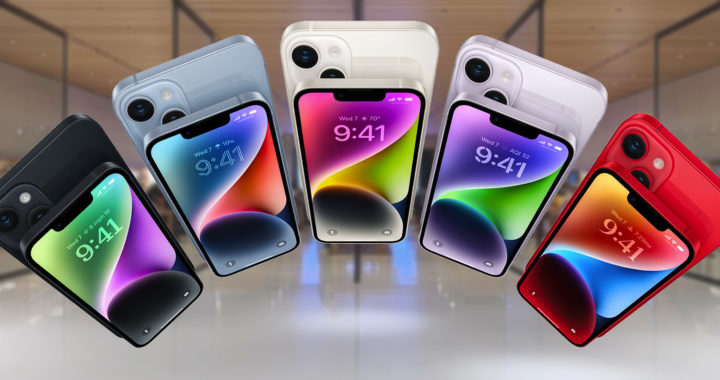The entire iPhone 14 line includes four smartphones. The iPhone 14 Plus is positioned as a mid-range smartphone alongside the iPhone 14 while the 14 Pro and 14 Pro Max are flagships from Apple. Those who are not too keen on purchasing a flagship due to budget constraints might be interested to check the mid-range models. Should you get an iPhone 14 Plus?
Pros of the iPhone 14
Reasons Why You Should Buy: Processing Capabilities, Durability and Reparability, and New Features
One of the biggest selling points of the iPhone 14 Plus is that it is as powerful as the 2021 flagships iPhone 13 Pro and iPhone 13 Pro Max. It uses the Apple A14 Bionic chip that enables it to compete with other flagship smartphones from 2021 and even several top-tier Android smartphones for 2022 in terms of processing performance.
The device is capable of handling graphics-intensive games and other resource-intensive applications such as photo and video editing. Key improvements from the previous generation are better battery life that can provide 26 hours of video playback and improved heat management to keep the phone cool and the user experience smooth.
Future-proofing is another advantage of the iPhone 14 Plus. This device sports the following features and standards for current-generation and next-generation connectivity: charging and interfacing via USB-C, wireless connectivity via Wi-Fi 6 and Bluetooth 5.3, and 5G cellular connectivity via the sub-6 GHz standard.
Durability is also another notable feature. It uses the same Ceramic Shield to protect the glass screen from scratches and fingerprints. It also has an IP68 rating that gives it resistance to dust, water splashes, and 2-meter water submersion for up to 30 minutes. This device is also easier to repair than previous generations due to its new design orientation.
There are also other upgrades to the camera system. The front-facing TrueDepth camera now supports Cinematic Mode at 4K and the 12MP main and 12MP ultra-wide rear cameras support newer camera features such as the Photonic Engine for capturing better color and details, Action Mode, and about twice better low-light photography.
Note that Apple has also introduced new features to the entire iPhone 14 line. These include emergency SOS via satellite communications, car-crash detection that automatically dials designated emergency numbers, and the new capabilities of iOS such as the customizable Lock Screen that allows users to add widgets and change fonts.
Cons of the iPhone 14
Reasons Why You Should Not Buy: Limited Improvements, Same-Old Design and Feel, Limited Capabilities
The iPhone 14 Plus is indeed the newest addition to the entire product line of Apple for 2022. However, it has several shortcomings. One of such is the fact that this smartphone is fundamentally a rehashed iPhone 13 Pro and 13 Pro Max. It uses the same A14 Bionic chip. The overall look and feel are the same. The notch is still there.
Part of the product strategy of Apple is to use similar components and design principles from its previous products to some of its newer products. This is cost-efficient. Nevertheless, for individuals looking for more significant upgrades or improvements, the 14 Pro or 14 Pro Max might be a better option than the 14 or the 14 Plus.
The top-tier iPhones have the Dynamic Island. It is a pill-shaped cutout on the center-top of the screen that houses the front-facing camera and components for the Apple FaceID. It provides added functionalities such as displaying interactive information and navigation features that dynamically activate and operate to improve user experience.
Another drawback of the iPhone 14 Plus is its processing capabilities. It indeed remains one of the fastest smartphones in the market. However, both the iPhone 12 Pro and Pro Max, as well as the iPhone 13 Pro and 13 Pro Max, remain capable smartphones. It does not make sense to upgrade to the newer iPhone for processing prowess alone.
The camera system might have improved but these improvements are not significant. The cameras of the previous two generations remain capable of taking decent photos and recording videos with near quality. The specific rear cameras in the 13 Pro and 13 Pro Max are still considered some of the best shooters in the 2021-2022 landscape.
Furthermore, while the Super Retina OLED display of this device remains as impressive as the previous generations, it lacks modern features found in flagship iPhones, as well as mid-range and flagship Android smartphones. These include a high refresh rate of more than 60Hz, adaptive refresh rate or the Apple ProMOtion, and an Always-On.
Quick Verdict
Upgrading the 13 Pro/Pro Max and the 12 Pro/Pro Max might be an unwise purchasing decision because of the aforementioned drawbacks and issues. However, the most rational purchasing decision is to upgrade to an iPhone 14 Plus coming from an iPhone 11 or older generations and mid-range-to-flagship Android smartphones of 2021.





